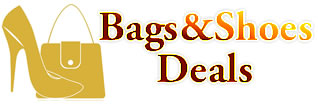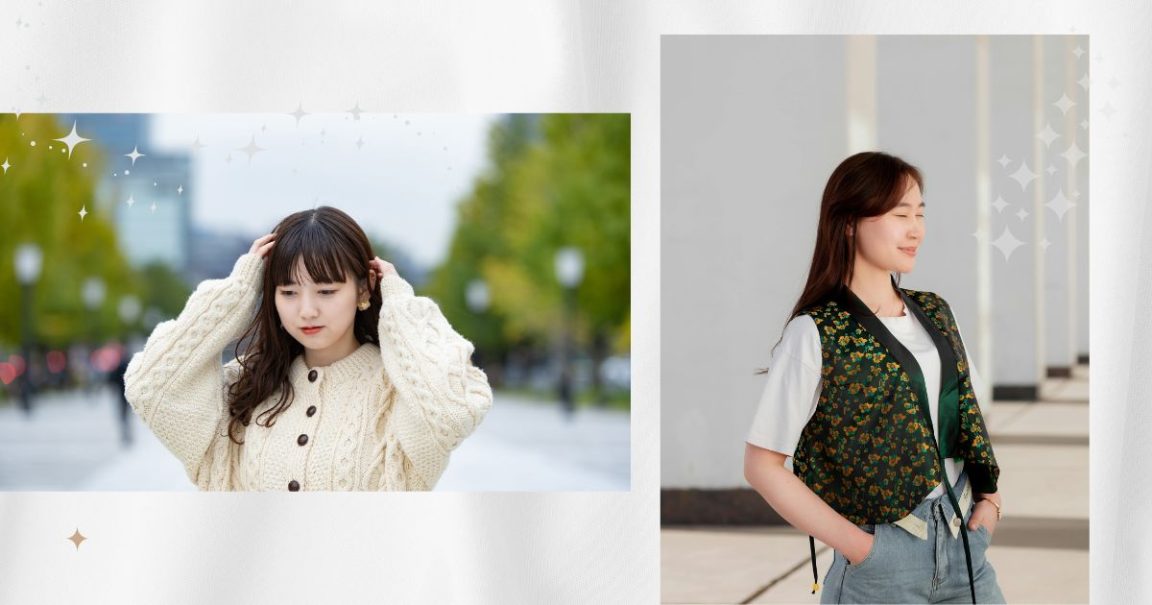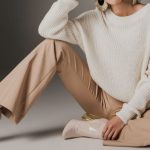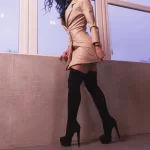Seoul’s streets have become some of the most stylish in the world, attracting fashion editors, influencers, and curious travelers eager to capture the latest looks. Korean street style has gained global popularity, driven by the rise of K-pop idols, K-dramas, and the increased visibility of Seoul Fashion Week. What makes it stand out is its balance between experimental creativity and polished minimalism, creating a fashion culture that pushes boundaries while still feeling wearable and refined.
From oversized silhouettes to gender-fluid dressing, Korean fashion reflects not just aesthetic choices but also social and cultural shifts. It has become a movement that blends confidence, identity, and individuality, setting the tone for what’s next in global style.
1. Oversized and Relaxed Fits
Oversized silhouettes have become a defining feature of Seoul’s streetwear culture, blending comfort with modern edge. Baggy pants, slouchy blazers, and roomy hoodies dominate sidewalks and style districts, offering a laid-back aesthetic that still feels intentional and fashion-forward. These pieces provide flexibility for layering, enabling outfits to transition seamlessly from casual daywear to refined evening looks without compromising their relaxed vibe.
Beyond aesthetics, the oversized trend reflects a broader cultural shift toward inclusivity and fluidity in the fashion industry. Moving away from rigid tailoring and body-conscious fits, relaxed cuts embrace freedom of movement and a gender-neutral appeal. This democratization of style challenges traditional notions of masculinity and femininity while encouraging individuality and self-expression. In Seoul, oversized fashion isn’t just a trend—it’s a statement about comfort, identity, and the evolving definition of modern style.
2. Monochrome and Minimalism
Monochrome dressing has become a cornerstone of Korean street style, with shades of black, white, beige, and muted grays dominating the fashion landscape. This approach emphasizes simplicity while still delivering striking visual impact through clean cuts, balanced proportions, and intentional styling. Rather than relying on bold prints or loud colors, the appeal lies in the subtle sophistication of pared-down palettes that draw attention to the overall silhouette.
Minimalism in Korean fashion also emphasizes detail and texture. Tailored trousers, structured coats, and crisp button-downs form the backbone of these ensembles, while accessories like sleek leather bags, chunky sneakers, or layered jewelry add depth without disrupting the aesthetic harmony. The result is a look that feels timeless, versatile, and adaptable—proving that simplicity, when executed with precision, can be every bit as expressive as maximalist trends. This understated elegance resonates strongly in Seoul’s fashion scene, where minimalism is celebrated as both practical and chic.
3. Athleisure as Everyday Wear
Athleisure has moved far beyond the gym and into the heart of everyday style, becoming one of Seoul’s most defining fashion statements. Joggers, track jackets, and sleek sneakers are no longer just weekend staples—they’re being paired with tailored coats, crisp button-downs, and structured handbags for a look that balances ease with refinement. Baseball caps and sporty hoodies often serve as casual accents, bringing a youthful energy to otherwise polished outfits.
What makes this trend particularly strong in Seoul is its adaptability to the city’s fast-paced lifestyle. Whether heading to work, a café, or late-night hangouts, athleisure offers comfort without sacrificing sophistication. It reflects the city’s love for blending functionality with high style, where performance fabrics, bold logos, and streamlined silhouettes are just as at home on the subway as they are in luxury boutiques. In essence, athleisure has become the uniform of modern Seoulites who want to move effortlessly through their day while looking sharp.
4. Layering as an Art Form
In Seoul’s fashion scene, layering is celebrated not just for its practicality against shifting seasons but as a canvas for creativity. Long coats worn over hoodies, crisp shirts tucked beneath silky slip dresses, and chunky sweaters casually draped over shoulders are just the beginning. Each added layer introduces new dimensions, playing with contrasts in texture, silhouette, and proportion. Think wool against satin, oversized tailoring offset by slim-fit pieces, or structured outerwear softened by flowy fabrics—it’s a visual dialogue that turns everyday outfits into style statements.
What sets Korean layering apart is the balance of effortlessness and intention. Fashionistas skillfully combine unexpected lengths—cropped jackets over maxi dresses, or trench coats styled with wide-leg pants—to achieve depth without clutter. Accessories often complete the effect, with scarves, belts, or crossbody bags used as extra “layers” to tie everything together. In a city where individuality thrives, layering has become a signature art form, showcasing both personal style and Seoul’s reputation as a global fashion capital.
5. Bold and Playful Accessories
Accessories in Korean street style are far from afterthoughts—they’re the exclamation points that finish the sentence of an outfit. Chunky sneakers dominate sidewalks, adding height and a sporty edge while balancing oversized silhouettes. Bucket hats remain a staple, bridging function and fashion with their casual, youthful vibe. Mini handbags, often in unexpected colors or whimsical shapes, serve as both statement pieces and conversation starters, proving that practicality doesn’t have to come at the expense of fun. Oversized glasses, whether tinted or clear-lensed, add a dash of retro charm and intellectual cool. At the same time, quirky jewelry—think mismatched earrings, layered chains, or rings in playful shapes—injects individuality into any ensemble.
What makes these accessories stand out in Seoul is how they transform minimalist foundations into head-turning looks. A simple black-and-white outfit suddenly feels runway-ready with neon sneakers or a sculptural handbag. Even subtle accents, like a brightly patterned scarf or a crossbody bag slung just so, can completely shift the vibe of an outfit. In a culture that values both detail and self-expression, accessories have become a playground for creativity, allowing wearers to explore their identity, push boundaries, and showcase their personality without a word.
6. Gender-Fluid Expression
A standout element of Korean street style is its fearless approach to gender-fluid fashion. Traditional boundaries are being blurred as men confidently wear crop tops, skirts, pastel knits, and delicate jewelry. At the same time, women opt for oversized blazers, boxy trousers, and sporty silhouettes that nod to classic menswear. This fluidity celebrates individuality, breaking free from conventional dress codes and encouraging wearers to experiment with self-presentation. The blending of masculine and feminine aesthetics isn’t just about clothes—it’s a cultural statement that embraces inclusivity, self-confidence, and creative freedom.
This shift reflects a growing movement toward fashion as a playground for identity rather than a set of rigid rules. On the streets of Seoul, one might see a tailored suit paired with pearl necklaces, or sneakers worn with a flowing pleated skirt, creating looks that challenge expectations and normalize versatility. By rejecting binary restrictions, Korean street style sets a progressive tone for global fashion, showing that style thrives best when it celebrates diversity and authenticity.
7. Pop Culture and K-Pop Influence
Korean street style wouldn’t be complete without the undeniable impact of K-pop and pop culture. Global icons like BTS and Blackpink don’t just perform on stage; they set trends that ripple through Seoul’s streets and beyond. BTS’s mix of sharp tailoring, bold prints, and casual streetwear inspires fans to experiment with layering and statement pieces. At the same time, Blackpink embodies a hybrid of edgy luxury and playful femininity, turning biker jackets, plaid skirts, and designer handbags into instant must-haves.
The influence of idols extends far beyond clothing—it creates a cultural loop where music, media, and fashion continually reinforce one another. Fans emulate idol looks not only to show admiration but also to feel part of a larger, shared identity. This connection blurs the lines between celebrity fashion and everyday wear, making sidewalks feel like impromptu runways. In effect, K-pop has transformed Korean fashion into a global phenomenon, proving that style, much like music, can unite people across cultures and continents.
8. Retro Revival
Nostalgia continues to fuel fashion trends, and Korean street style embraces retro aesthetics with an inventive twist. ’90s-inspired denim—think high-waisted jeans, distressed jackets, and oversized cuts—pairs effortlessly with vintage sneakers that have become collectors’ items in their own right. Plaid shirts tied around the waist, varsity jackets, and throwback graphic tees nod to classic youth culture, while Y2K elements, such as butterfly clips, beaded necklaces, and mini shoulder bags, inject playful energy into outfits.
What makes this revival uniquely Korean is the modern reinterpretation. Instead of replicating looks from the past, style enthusiasts remix retro staples with contemporary tailoring, luxury pieces, or minimalist elements. The result is an elevated nostalgia that feels familiar yet distinctly current. On the streets of Seoul, it’s common to see a 2000s-inspired handbag paired with sleek monochrome tailoring, or chunky sneakers worn with clean, oversized coats—a seamless fusion of past and present.
9. Statement Outerwear
With Seoul’s chilly winters and unpredictable transitional seasons, outerwear isn’t just practical—it’s a fashion focal point. Jackets often dictate the overall mood of an outfit, with oversized trench coats, structured leather blazers, and classic bomber jackets being go-to choices. Puffer jackets in bold colors or exaggerated shapes make a bold statement, transforming everyday streetwear into runway-worthy pieces.
Outerwear in Korean fashion is as much about personality as it is about warmth. A camel trench layered over a hoodie creates a smart-casual balance, while a glossy black leather blazer paired with sneakers and wide-leg pants delivers edgy sophistication. Even sporty pieces, like varsity jackets or quilted bombers, are styled in ways that highlight individuality and flair. By treating outerwear as the centerpiece rather than an afterthought, Korean street style transforms necessity into a form of art.
10. Techwear and Futuristic Elements
In a city as forward-thinking as Seoul, it’s no surprise that techwear has carved out a prominent niche in street fashion. Defined by utilitarian design, it features functional details such as multiple cargo pockets, adjustable straps, tactical vests, and water-resistant fabrics. These pieces combine sleek, urban aesthetics with everyday practicality, appealing to those who value both style and function. Futuristic sneakers with bold soles, reflective details, and performance-ready builds complement the look perfectly.
Beyond practicality, techwear embodies the spirit of innovation and urban resilience. Its streamlined silhouettes, monochrome palettes, and engineered fabrics reflect a lifestyle that’s adaptable to Seoul’s fast-paced, ever-changing environment. For many, techwear also carries a cultural resonance—merging Korea’s technological identity with fashion in a way that feels authentic and futuristic. The result is a street style that looks as ready for the subway as it does for a sci-fi movie set.
Seoul as the Global Style Capital
Korean street style is more than a collection of trends—it’s a cultural force shaping how the world dresses. Its influence is visible not only in Asia but in the runways of Paris, New York, and Milan, where designers borrow from Seoul’s boldness and creativity. Whether it’s oversized fits, gender-fluid styling, or retro revivals, Korean fashion continues to push boundaries while staying deeply authentic.



